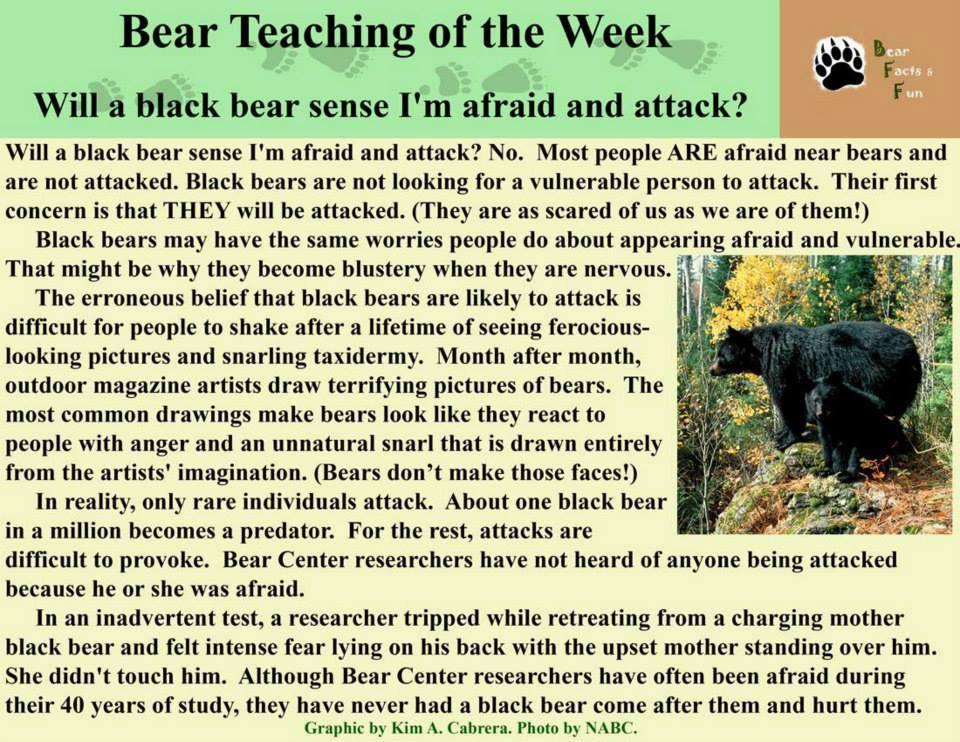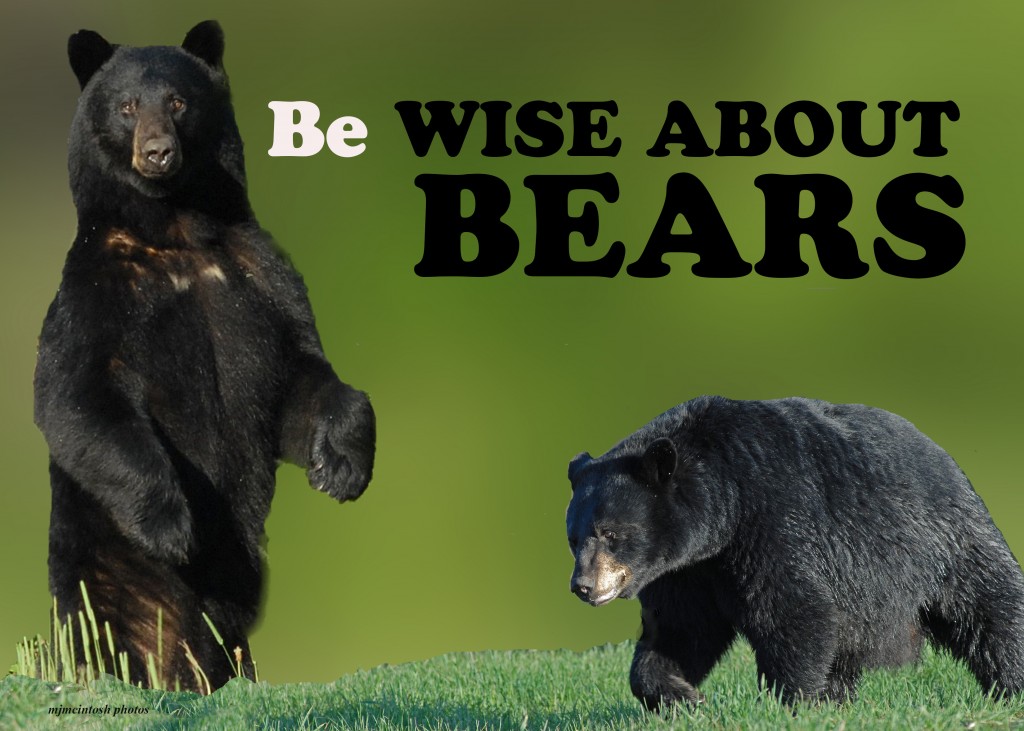Are Bears Dangerous?
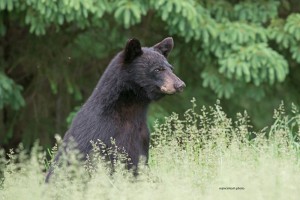 When bears lose their fear of people, are they more likely to attack? Answer is NO ! !
When bears lose their fear of people, are they more likely to attack? Answer is NO ! !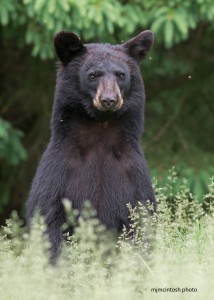
Bear researchers across America have found that such bears are no more likely to attack, and may be less likely to attack, than other bears. Here is a summary of the evidence, starting here near Ely. In nearby Eagles Nest Township, MN, residents have fed wild black bears for over 40 years. Dozens of bears have lost their fear of people over the years. No one was attacked. A story about one of those bears is posted here in the Bear Center in “Bears in the News.” See “Ed Orazem: the man who feeds bears” in the Ely Echo, August 26, 1985.At the Vince Shute Wildlife Sanctuary near Orr, MN, people have hand-fed and petted hundreds of wild black bears for decades. Until the mid-1990’s, the public was free to mingle with the wild bears without rules or supervision. People teased bears with food for pictures. Toddlers steadied themselves against 500-pound bears. People lifted children up to bears’ mouths for reasons beyond understanding. There were occasional nips and scratches, but no attacks.Around Ely, researchers have worked closely with wild black bears since 1969 (plus 2 previous years in Michigan). No bear came after them and hurt them. In the last 2 decades, Ely researchers and 100+ volunteers spent thousands of hours walking with dozens of black bears, including mothers with cubs (Rogers and Wilker 1990). There were occasional nips and scratches, but no attacks. The more accustomed the bears became to observers, the more they ignored them, as can be seen in videos here in the Bear Center.In Michigan, Dr. Terry DeBruyn spent 4 years walking with wild black bears, including mothers with cubs, for his Ph.D. The bears did not attack anyone. Read his experiences in Walking With Bears here on the Book Table.In
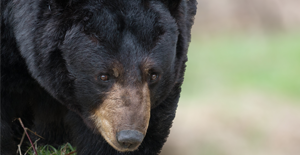 Pennsylvania, Dr. Gary Alt spent over a decade studying a 7-square-mile community called Hemlock Farms where 7,000 people coexisted with 21 bears. That many bears in 7 square miles is a higher bear density than exists in any national park or national forest. People regularly hand-fed the bears. No one was attacked.In Smoky Mountains National Park, Dr. Jane Tate studied wild black bears that people fed along roadsides (Tate 1983). She watched in disbelief as raucous tourists crowded around bears to hand-feed them, pour beer over their heads, lure them into cars for photos, and put honey on kids’ faces for bears to lick. She reported that the bears were “amazingly tolerant and restrained.” When people tried to pet bears that were not used to it, some bears defensively nipped or cuffed people, causing minor injuries, but the bears did not attack. The more accustomed to people the bears became, the less likely they were to cause injury.Between 1900 and 2007, wild black bears killed 60 people across North America. None of these bears were accustomed to being fed or petted. Forty-seven of the killings were in remote areas of Canada and Alaska where people and bears have little contact. Only 3 were in eastern states (2 in Tennessee, 1 in New York) where encounters are frequent. See more on these killings elsewhere in the Bear Center.For decades, people mingled with black bears at garbage dumps where bears had lost their fear of people. In 1989, a researcher asked hundreds of bear biologists at an Int’l Bear Conference if they had ever heard of anyone being attacked at a garbage dump. No one had. Near Grand Marais, MN, Jack Becklund formed close relationships with 10 bears around his rural residence during 1990-1995. His book Summers with the Bears tells of his experiences. No one was hurt.
Pennsylvania, Dr. Gary Alt spent over a decade studying a 7-square-mile community called Hemlock Farms where 7,000 people coexisted with 21 bears. That many bears in 7 square miles is a higher bear density than exists in any national park or national forest. People regularly hand-fed the bears. No one was attacked.In Smoky Mountains National Park, Dr. Jane Tate studied wild black bears that people fed along roadsides (Tate 1983). She watched in disbelief as raucous tourists crowded around bears to hand-feed them, pour beer over their heads, lure them into cars for photos, and put honey on kids’ faces for bears to lick. She reported that the bears were “amazingly tolerant and restrained.” When people tried to pet bears that were not used to it, some bears defensively nipped or cuffed people, causing minor injuries, but the bears did not attack. The more accustomed to people the bears became, the less likely they were to cause injury.Between 1900 and 2007, wild black bears killed 60 people across North America. None of these bears were accustomed to being fed or petted. Forty-seven of the killings were in remote areas of Canada and Alaska where people and bears have little contact. Only 3 were in eastern states (2 in Tennessee, 1 in New York) where encounters are frequent. See more on these killings elsewhere in the Bear Center.For decades, people mingled with black bears at garbage dumps where bears had lost their fear of people. In 1989, a researcher asked hundreds of bear biologists at an Int’l Bear Conference if they had ever heard of anyone being attacked at a garbage dump. No one had. Near Grand Marais, MN, Jack Becklund formed close relationships with 10 bears around his rural residence during 1990-1995. His book Summers with the Bears tells of his experiences. No one was hurt.
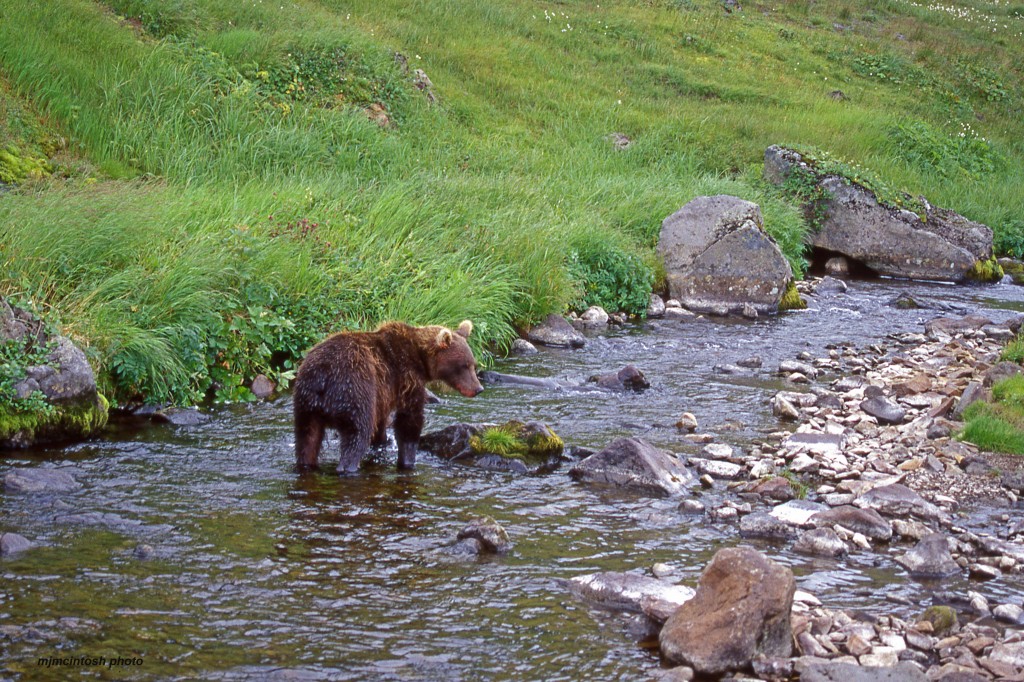 But what about grizzly bears? At McNeil River Sanctuary in Alaska, people have closely observed grizzly/brown bears ever since the area became a sanctuary in 1967. No fences separate bears from people. Bears fight, mate, and nurse cubs within a few feet of observers. In over 60,000 encounters, no one has been hurt (Herrero et al. 2005).In Yellowstone National Park, grizzly bears that have lost their fear of people forage beside roads, ignoring tourists who vie for pictures. Dr. Stephen Herrero (2005) wrote that these bears have not injured any bear-viewers and “are less likely to attack hikers or bear viewers on a per-encounter basis.”In Alaska, Dr. Stephen Stringham leads bear-viewing groups to watch grizzly bears that are accustomed to close observation. On the basis of over 10,000 encounters, he wrote, “There is little risk of being mauled by fully acclimated bruins.
But what about grizzly bears? At McNeil River Sanctuary in Alaska, people have closely observed grizzly/brown bears ever since the area became a sanctuary in 1967. No fences separate bears from people. Bears fight, mate, and nurse cubs within a few feet of observers. In over 60,000 encounters, no one has been hurt (Herrero et al. 2005).In Yellowstone National Park, grizzly bears that have lost their fear of people forage beside roads, ignoring tourists who vie for pictures. Dr. Stephen Herrero (2005) wrote that these bears have not injured any bear-viewers and “are less likely to attack hikers or bear viewers on a per-encounter basis.”In Alaska, Dr. Stephen Stringham leads bear-viewing groups to watch grizzly bears that are accustomed to close observation. On the basis of over 10,000 encounters, he wrote, “There is little risk of being mauled by fully acclimated bruins.
Bears that are used to seeing people are less likely to flee but are no more likely to come after people and hurt them than any other bear.Does this mean people should approach wild bears and attempt to feed and pet them? Does it mean bears can live around people like pets?No.When people touch wild bears that are not used to being touched, the bears may shy away or occasionally nip or slap, causing minor injuries. Bear Center researchers do not consider these mild defensive reactions to be attacks.
In 40 years of working closely with wild black bears, North American Bear Center researchers Dr Lynn Rogers and Sue Mansfield have never had one come after them and hurt them
What if I Get Between a Black Bear Mother and Her Cubs? One of the biggest misconceptions about black bears is that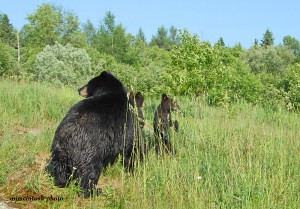 mothers are likely to attack people in defense of cubs. That is a grizzly bear trait. 70% of the killings by grizzly bears are by mothers defending cubs. But there is no record of a black bear killing anyone in defense of cubs. In fact, mothers with cubs were involved in only 3 of the 60 killings by black bears across America since 1900, and none of those 3 killings appeared to be in defense of cubs. Non-fatal attacks are also rare. By attacks, we mean mothers coming after someone and hurting them — not minor injuries associated with people hand-feeding them. Maybe a dozen people have had their feet bitten when they tried to escape up trees. Attacks on the ground are very rare. When humans confront black bear families in the woods, the bears almost always retreat or climb trees. If the cubs climb trees and the mother remains nearby, the mother may show bluster. This makes her appear ferocious, but it simply means she is nervous. Blustery expressions include: the mother blowing sharply as she hits the ground or the tree with a paw. the mother pouncing toward the person, blowing explosively, and slamming both feet on the ground. the mother moaning in fear, which many people misinterpret as a growl. huffing, showing anxiety. This is all harmless bluster.
mothers are likely to attack people in defense of cubs. That is a grizzly bear trait. 70% of the killings by grizzly bears are by mothers defending cubs. But there is no record of a black bear killing anyone in defense of cubs. In fact, mothers with cubs were involved in only 3 of the 60 killings by black bears across America since 1900, and none of those 3 killings appeared to be in defense of cubs. Non-fatal attacks are also rare. By attacks, we mean mothers coming after someone and hurting them — not minor injuries associated with people hand-feeding them. Maybe a dozen people have had their feet bitten when they tried to escape up trees. Attacks on the ground are very rare. When humans confront black bear families in the woods, the bears almost always retreat or climb trees. If the cubs climb trees and the mother remains nearby, the mother may show bluster. This makes her appear ferocious, but it simply means she is nervous. Blustery expressions include: the mother blowing sharply as she hits the ground or the tree with a paw. the mother pouncing toward the person, blowing explosively, and slamming both feet on the ground. the mother moaning in fear, which many people misinterpret as a growl. huffing, showing anxiety. This is all harmless bluster.
Text courtesy of www.bear.org / Dr Lynn Rogers and Team and Michele Chartier/BFF Michele Facebook.
Photographs – Mike McIntosh except for graphic at top of page.

